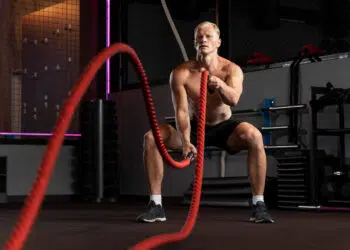Cardio and Muscle Growth
One of the larger debates in the field of weight training and bodybuilding is the question of whether or not cardio or any type of aerobic type activity should be performed when the goal is maximum gains in muscle mass. On one side of the argument is the idea that trainees should perform an hour of low-intensity cardio daily during their mass gaining phase. The idea is that this is a way of staying lean during the period of overfeeding needed to maximize muscle gain. On the other side is the idea that any activity outside of lifting weights will do nothing but harm gains in muscle mass and strength.
The truth lies somewhere in the middle, and I’d like to look at some of the various pros and cons of keeping some form of cardio in the overall program when the explicit goal is muscle mass gains.
They type of cardio that is usually prescribed or avoided when attempting to gain maximal muscle mass is of the steady state, moderate intensity variety.
Very few people will argue that high-intensity interval training is an effective method of building muscle mass.
There is definitely some logic to how sprints should work to build muscle mass, due to the hormonal elevations of the anabolic kind that occurs as a result, but the reality is that intervals don’t really work in conjunction with muscle mass building.
Level Up Your Fitness: Join our 💪 strong community in Fitness Volt Newsletter. Get daily inspiration, expert-backed workouts, nutrition tips, the latest in strength sports, and the support you need to reach your goals. Subscribe for free!
In this article, I’m going to focus on the various advantages to doing cardio when building muscle mass. In the follow-up to this article, I’ll take a look at the disadvantages, and see if some sort of decision can be made with all of the information, as to whether cardio is of benefit or harm, to growing muscle.
Done at low, or moderate intensities, cardio can act as a form of active recovery.
By pumping blood through worked muscles, recovery is actually accelerated. Active recovery actually helps more than simple passive recovery, meaning just sitting around. In order for this to affect the entire body, as most cardio machines are lower body dominant, something like an elliptical trainer, or rowing machine should ideally be used. It is also worth considering drinking a carb and protein drink while doing this moderate, full body cardio, to enhance nutrient delivery to the working muscles, thereby advancing the recovery process.
The impact of exercise on appetite can be different for everyone. Some notice that exercise can blunt appetite, and for others, it can stimulate it. Moderate intensity cardio seems to usually stimulate appetite, as it is low enough in intensity so as to not cause much in the way of adrenaline release. By doing so, those who have trouble consuming sufficient calories often find that including moderate amounts of cardio can be beneficial in terms of improving appetite.
If you are the type to either purely mass train, or purely focus on the cutting phase, you can lose a lot of your metabolic conditioning when you move into the pure mass gain phase, where all you are doing is weight training.
Lower repetition and long rest interval types of training tends to have the greatest impact and causes the loss of a large amount of conditioning and work capacity during this phase.
When conditioning levels drop, so does the body’s ability to recover, and that is obviously detrimental to muscle mass building. Another advantage to doing a low-level of cardio throughout the mass building phase is that it requires considerably less effort to maintain some degree of cardiovascular conditioning than it does to develop it again from a state of being unconditioned.
Another benefit of aerobic activity is that it could potentially improve results during a mass gaining phase with overall calorie partitioning. The most effective form of calorie partitioning that we have at our disposal is weight training.
Regular muscular contractions increase nutrient uptake into skeletal muscle.
This means that less excess calories get stored in fat cells. It’s debatable how much of an effect low or moderate intensity cardio will have in this, it certainly won’t hurt if done in reasonable amounts, and it will likely help in the long-term as well.
There is also the issue of keeping fat burning pathways active and/or staying lean while mass gaining. As you’ll read in the Aerobic vs Anaerobic Training for Fat Loss articles, cardio isn’t the most effective method of fat loss to begin with, but it does help create a caloric deficit – provided you don’t just eat more to compensate for it, but we aren’t really discussing fat loss in this article.
Regardless of this, a reason you may want to keep doing some cardio is that if you are gaining muscle mass, you likely will eventually want to lean out. As I discussed in my Lean Bulk articles, most will get the fastest rate of muscle growth while allowing some fat gain to occur, and the simple fact is that this fat will eventually have to be lost through dieting. If that is the case, then you may as well mitigate some of the fat gains.
Part of the reason that steady state cardio is not considered effective as a fat loss tool is because often during a bulking phase, or a period of layoff where a lot of eating occurs, the body often loses its efficiency at using fat as a fuel source. If this period is then followed by dieting and cardio, it can take the body a few weeks to be able to supply ample amounts of fat for fuel, and during this time the most likely muscle is sacrificed. This partially explains why when beginning a diet, it can take a week or two before the results start to be noticeable. The above scenario is even more pronounced his seems to be even more pronounced when there has been no cardio done during the mass building phase, or during the lay off from weight training.
Happy Lifting!













